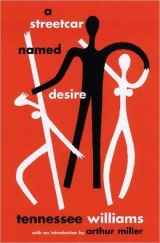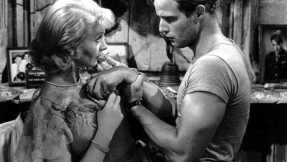A Modernist Trait in ‘A Streetcar Named Desire’: Happy Endings are Overrated
During the nineteenth and early twentieth centuries, a new movement began to take shape that fundamentally changed the style of literature. This movement is known as modernism. Towards the end of this era, Tennessee Williams wrote the play A Streetcar Named Desire and, even though modernism was on the decline, it is still considered a modernist work. There are many qualities that define modernism, but chief among these is the unresolved ending—a trait found in the last scene of Williams’s play. A closer look at this particular modernist element can provide a deeper understanding of A Streetcar Named Desire and modernism in general.
The Big Picture: Modernism

It is safe to assume that almost any movement in the arts is an act of rebellion against the prevalent norm. In the late eighteenth century, Romanticism rebelled against the rational order of the Enlightenment and, instead, celebrated the sublime nature of literature. These artists believed that reason couldn’t explain everything and produced works such as Mary Shelley’s Frankenstein. Over half a century later, Naturalism took up the fight with a literary movement that favored an uncompromisingly realistic approach to art over the former idealized approach of Romanticism. Naturalists—or realists—focused on generating characters that behaved in accordance to their animal impulses, or “natural desires.” Lord of the Flies by William Golding is one such book.
Towards the end of the Naturalism movement and the beginning of the twentieth century, the world exploded with modern ideas. Freud brought fresh insights to the realms of psychology and sociology. Einstein postulated a new and fascinating theory of relativity. Information technologies such as the radio and TV emerged. A philosophy of racial superiority surfaced in Germany. During this time, several modernist works began to appear, but modernism didn’t peak until right after World War I. As warfare escalated to a global level, writers decided that the genteel tradition of literature was too outmoded for this era of violence; thus, modernism was born.

By definition, modernism is “a style or movement that aims to break with classical and traditional forms,” or, as Ezra Pound’s motto goes, “make it new!” From contradictory, ambiguous characters to the style of “stream of consciousness” writing, modernists took their rebellion to a new level. These writers sought new and unique ways to rebel against not only former ideas, but also the very structure of writing. E.E. Cummings’s use of lower-case letters is a prime example of this avant-garde thinking.
In this sense, Modernism meant that the traditional endings were not invited to the party. “Happily Ever Afters” were no longer considered “new,” and unresolved endings began to take their place. To clarify, here’s a comparison of what an ending may have looked like among the different movements mentioned before:
Romanticism: An aristocrat man falls in love with a woman beneath his station (i.e. a servant) and they are wed in a Happily Ever After. In other words, the ending is impulsive and unexpected.
Naturalism: The aristocrat and the servant get married, but they grow distant after a miscarriage. In other words, the ending is imperfect, but realistic. Life doesn’t end when the Happily Ever After wedding does.
Modernism: After the wife’s sudden miscarriage, the story ends with the husband asking for breakfast in bed the next day. * In other words, there is no clear resolution or ending.
Zooming in: A Streetcar Named Desire

A Streetcar Named Desire begins with Blanche DuBois, a fragile Southern Belle who suffers from a humiliating past and now prefers to live in her own imagination. She decides to go and stay with her sister, Stella, who lives in New Orleans. Upon arrival, Blanche immediately finds herself an enemy in Stella’s husband, Stanley–a brutish, sensual man who is suspicious of Blanche’s façade. Over the course of the play, their tense relationship continues to escalate until Stanley ultimately rapes Blanche and commits her to an insane asylum. A few weeks after the sexual assault, the last scene opens with Blanche taking a bath while Stella packs her bags and Stanley plays poker in the other room. Blanche believes that her fictional millionaire is coming to whisk her away and doesn’t understand why a doctor from an asylum shows up instead. After an initial struggle, she eventually allows herself to be led away, and the play ends with Stanley comforting Stella as she cries, while his friend Steve starts up another round of poker. For a final scene, this scene leaves things far from finalized. The viewers are aware that something isn’t quite right, that the ending isn’t quite appropriate, that the problem isn’t quite fixed.
A closer look at this scene reveals more about this unresolved ending. First and foremost, the play ends without any punishment for Stanley. Initially, Stanley is a charming young man, if only a little crude. This image slowly deteriorates into something darker and more disturbing when Stanley first beats his pregnant wife and later rapes Blanche. However, the last image the audience sees of Stanley is the model family man—a husband comforting his wife as she holds their newborn baby. After Stanley’s earlier actions, the wrongness of this image causes the audience to question the ending. Why isn’t Stanley kicked out of the house? Why isn’t Blanche rescued? Simply put, these questions are the exact kind of traditional Happily Ever After that modernism strives to avoid. A linear plot with a clear resolution will not be found in this modernist play.

The audience is also left wondering what will happen to Stella. If she believed Blanche’s story about the rape, she would not be able to continue living with Stanley. In a sense, the two sisters’ roles reverse. By choosing not to believe Blanche, Stella is choosing a world of make-believe—the same world in which Blanche built a false existence to hide from her past. On the other hand, Blanche chooses to withdraw into madness, so that Stella doesn’t have to acknowledge the horrifying truth. If Blanche appeared sane, Stella would have to give Blanche’s story more credibility. A traditional story would not allow Stella to ignore such a grievance. However, this is not a traditional story, it’s a modernist one. Even though Stella seems somewhat content with this sham reality, the audience wonders what would happen if she accepted the truth.
The play’s last line is the final puzzle piece of the unresolved ending. Steve announces that another poker game—”this game is seven-card stud”(179)—is about to begin, embodying the “bluffing” that takes place in Stanley and Stella’s household. In a traditional story, the lies would be uncovered and dealt with. However, this play leaves the lies lurking behind. Not all the cards have been laid out on the table, much like reality in general. The poker game subtly reminds the audience that the game at the Kowalskis can always change.

Whether it’s seven-card stud, Stella’s ignorance, or the lack of punishment for Stanley, the details in this last scene can reveal more about the play’s unresolved ending. In light of this insight, A Streetcar Named Desire provides an opportunity to better understand modernism and how it has changed literature overall.
*This example is similar to the central plot of James Joyce’s Ulysses, one of the most well-known modernist works at the time.
Works Cited
Williams, Tennessee. A Streetcar Named Desire. New York: Signet, 1974. Print.
“Some Characteristics of Modernism in Literature” <http://www.sprog.asb.dk/tt/Giddens/Lectures/some_characteristics_of_modernism.htm>
What do you think? Leave a comment.











Personally I found the play to be utterly disconcerting. The dynamics between Stella, Stanley, and Blanche was weird from the start. Stanley’s character was nothing, but brute force all through the play while Blanche was this ethereal character that had no real weight in her presence or dialogue. Yet she kept me engaged enough in her storyline that I felt obligated to finish the play. Stella’s character made me want to shake her and tell her to open up her eyes of her husband Stanley’s shortcomings.
It is talented writers like Williams that remind why I hate the boring scripts of movies today.
I have watched the 1951 film directed by Elia Kazan and was quite compelled to read the actual play afterward. Although I’d read Tennessee Williams in high school, this particular play was not a part of the curriculum (likely due to the play’s content). I am glad I did not read this play when I was younger because I probably would not appreciate it as much.
I have not read too many plays, but this one was certainly worth reading. A true modern American classic. It’s no wonder the play has been produced in so many countries around the world for the last decades.
YES. THIS. We need more writers like Tennessee Williams. Happy-ever-afters are so overdone, Williams was ahead of his time for writing something that didn’t send readers off feeling fulfilled and giddy. Perfect analysis!
Occasionally, I wonder why it’s that English teachers insist on forcing us to read such painful rubbish? Is it because they want to see how many of their students commit intellectual suicide, or simply is it a means of inflicting pain upon them so that at end of the year they can emerge much stronger and more capable. I know this sounds a little extreme, but then again this play is also quite extreme in an of itself.
That was a reply to Shalanda’s comment.
One of my favorite. It paints all of female strengths and weaknesses in such a delicate way.
There are quite a few underlying topics that go undisguised; social context for example. Was it considered appropriate for Stella to have left he husband for a crazy woman’s heresy?
Excellent point! At the time this play was written, the feminist movement was well underway (the 19th amendment was passed 20 years prior), so I would think that Stella did have SOME freedom to leave her husband, but clearly her mentality seemed to be more traditional. So, perhaps Stella has some purpose as a political commentary on women’s rights at the time.
I don’t know if you’re already aware but some early audience members cheered when Stanley took Blanche away to rape her! Because of the social attitudes at the time, I think we could say this may have been a clear resolution to some, especially if we view Stanley as representing the new way of life in America and the working class and if we see sex for him as a tool to dominate others and resolve imbalances of power. It could then be a pretty well ‘resolved’ (not to approve of Stanley’s actions but from a structural POV) ending, the working class has dominated the upper class Old South, Stanley has re-established his position as the ‘king’ of his house and would most likely have been believed over a known liar and a woman. Although, it’s defiantly not a ‘happy ending’!
If I could describe this play in one simple word, it would be: AMAZING! In the beginning, I thought this would be another boring book assigned to us in English class, but this time I was extremely wrong. As soon as I read the title, I thought to myself that I just might be wrong. Turns out I was wrong because the book was extremely fun to read and discuss in class. Thanks for the article.
What a wonderful article! I absolutely adore Streetcar and you discussed it so well. The ending is so crazy and the play just really is a great work. I love all the music in it as well, some of the best stage directions I’ve ever read. I loved how you talked about Blanche and Stella’s role reversal. You have a good eye. Great job.
Excellent analysis of Streetcar. I suppose I have never thought of the play as being modernist, however, my recent attendance at the Tennessee Williams Literary Festival in New Orleans and a viewing of Woody Allen’s take on the play in Blue Jasmine has caused me to give the play a great deal of thought lately. I have plans to read the play again in the near future and I will certainly think of your article when I do. I suppose that Allen’s interpretation is, indeed, an ultra-modern example of this story, leaving out the rape, adding the “real” Madoff-type millionaire husband, and leaving the audience completely clueless as what happens to the pseudo-heroine at the end. I agree that in Streetcar the unresolved issues seem to be more with Stella and Stanley than with Blanche. Along modernist lines, Streetcar and Joyce’s Ulysses do have something in common. Stephen Dedalus disappears into the night and it’s Molly and Leopold Bloom that we’re left with in the end.
Thank you for this deconstruction. I have thought about this idea before but have never been about to put it into words.
An ambiguous ending can sometimes be more satisfying than a romantic one. My generation has grown up saturated with trite storylines fed to us with a spoon. A modernist ending can be refreshing and more true-to-life. The truth is, a woman like Stella would most likely stay with Stanley and a man like Stanley would most likely hide it all away. There would not be a resolution.
One ought to take a movie for what it is. Legally Blonde is meant to be trite and romantic with a sunny happy ending. Marnie is meant to be dark and intense with an ambiguous ending. I believe we could all appreciate movies of all kinds much more if we were mindful of its purpose. Because European Road Trip was not made to win an Oscar.
I always love a good history lesson! Thanks for the great article!
Unresolved endings can really be the marker of great literature, and I can’t help but connect the finale of ‘Streetcar’ to the similarly feminist themed and somewhat sensationalized tale of Frances Farmer. Women are so often the helpless victims, the voiceless figures that are swept away in a life of entrapment and unjustness. Would Stella have been tricked like this if she were a man? Doubtful. Would the same fate be given to her if it were a woman who recommended it, and not Stanley, the ‘head of the house’. This article sheds some light on Williams’ intentions–thanks for the read!
It took me a long time to get used to modernist readings, bit I’m glad I did because romanticism in novels was way overdone.
I think the benefit of having a modernist ending is that is definitely allows for the reader (or viewer, in a film’s case) to come up with an ending they see fit. In “Streetcar,” for example, one could choose to think that Stanley gets punished for his crimes, while Blanche doesn’t end up in an asylum. As you said, Modernism isn’t constricted by providing the typical “Happy ending.” Ultimately, I prefer these kinds of endings because they allow for a discussion of everything that led up to that moment.
To see the dichotomy of the realism of Williams and the sanitized expectaions of the Hollywood of his time all one has to do is watch the Paul Newman film version of Cat on a Hot Tin Roof which removes the homosexual underpinnings which was the soul of Williams’ play.
I think it’s particularly interesting to look at how blatantly sanitized the ending of the film is when compared with this shocking, chilling, and abrupt ending. It’s amazing to see how far behind literature Hollywood was, as the film industry was still (and, frequently, now even still is) stuck in the idealized idea of wrongs being punished, even if Blanche’s tragedy remains. Stella has much more agency at the film’s close as she leaves with their child and vows to “never go back,” while Stanley is left playing the games she refuses to take part in anymore. And yet this changes the world of Williams’ play so much that it does such a disservice to all of these characters and their period. The play’s inherently unresolved feeling is part of what makes it so powerful, and you’ve perfectly articulated that here. Great work!
Thank you this gave me better insight!
Thank you for this article, it has given me a better understanding of both-The play and literary modernism.